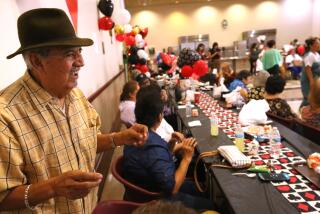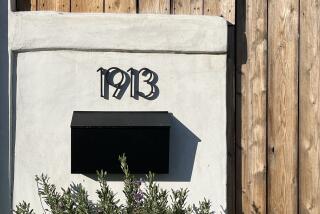Once-Proud Suburbs Fail to Age Gracefully
- Share via
COLLINGDALE, Pa. — The neatly aligned rows of attached homes were once inhabited by the families of workers who toiled in nearby factories.
Eighty-five-year-old Tony DeVito was one of them, working at a now-closed Westinghouse factory in nearby Lester, where hundreds of employees made turbines. And, though plenty of people still pass the handful of Collingdale’s downtown shops on their way to the trolley to Philadelphia, the borough’s population is falling. The 2000 census put it at 8,664 residents, down 18% from its 1970 peak of 10,605.
“I don’t know what it’s going to be like in, say, another 10 years. I don’t think this neighborhood will be any better than some places in Philadelphia. It’s heading downhill,” said DeVito, standing on the front porch of his early 1900s brick row house. “Taxes are pretty high.... I would like to move out farther, near my brothers and sisters.”
Across the country, old, often small suburbs such as Collingdale that were among the first to welcome the cities’ middle class are seeing their populations dwindle or stagnate while outer suburbs grow. The people who remain tend to be older, poorer and in greater need of social services--from elderly care to unemployment assistance. And that, experts say, could threaten the long-term economic and social health of the region.
Nowhere is the national shift more apparent than in Delaware County in suburban Philadelphia. The grid-like streets of its older, inner-ring suburbs just outside the city limits are filled with older homes. The western towns, on the other hand, are dotted with farms, bright strip malls and brand-new developments where three-bedroom, two-bath houses start around $250,000.
Roughly bisected by Interstate 476, Delaware County’s boroughs and townships between the highway and Philadelphia saw a population decline of about 2.2% between 1990 and 2000. To the west of the highway, farther out, the number of residents grew by almost 5%.
The trend can be seen in older cities across the country, in suburbs outside Detroit, Pittsburgh, even Boston.
And for every shrinking suburb such as Collingdale or Northwoods, Mo., near St. Louis, there is a Collegeville, Pa., or Wildwood, Mo., outer suburbs where the population ballooned about 90% during the 1990s.
The explanations are numerous.
Among the clearest is the availability of cheap land. Americans’ love for their cars and tolerance of long commutes has only bolstered the shift.
That’s what is happening in Collegeville, about 25 miles northwest of Philadelphia.
Judy Miller, a real estate agent for 19 years, said pharmaceutical companies have drawn thousands of workers to the area. Other residents simply prefer a place where new luxury homes sit next to wide-open farms.
“People tolerate the commute because they want to be in a more rural area. We have all the conveniences here, all the shopping they need, good schools,” Miller said. “They’re willing to commute to get more house for their money.”
Those left behind by the migration create greater demand for social services.
“You had poorer communities being asked to provide more services for people who increasingly couldn’t pay for the services,” said Bill Fontana, executive director of the Pennsylvania Downtown Center, a nonprofit group that encourages downtown development. “It’s a real nasty downward spiral.”
It’s much the same as the downward spiral that has threatened big cities for decades.
But the suburb’s size works against it.
“Many of these communities are small in terms of population and tax base,” so falling tax revenues can more easily hurt city budgets, said Barry Seymour of the Delaware Valley Regional Planning Commission in Philadelphia.
That’s a problem facing Bucks County. Home to one of the original car-centric suburbs, Levittown, its older bedroom communities are competing with new housing developments 25 miles from downtown Philadelphia.
Manufacturing was strong when the old suburbs were built in the 1950s and ‘60s. But manufacturers, from steel plants and their ancillary businesses to textile mills, moved away, taking jobs with them.
For example, Fairless Works, a sprawling U.S. Steel plant along the Delaware River, once employed more than 8,000 workers who each year made more than a million tons of cold rolled steel and tin mill products. Today, all that’s left on the site, where overgrown grass is overtaking corrugated metal buildings, is a remnant of the business and a few hundred workers.
But the county is trying to turn things around by helping the communities find ways to reuse industrial sites, subsidize public transit and use tax breaks to encourage development along the river, said Lynn Bush, executive director of the county planning commission.
Officials want to improve public access to the river -- the county has about 75 miles of Delaware Riverfront -- by converting old industrial sites to housing, office buildings or parks. Known for its quaint antique shops and farmland, Bucks County also has an aggressive program to save open space, funded by a $59-million bond issue approved by voters in 1996.
“We’re trying to focus on what’s really important to us, what makes Bucks County special,” Bush said. “We need to recognize that it’s a waste of resources to abandon the useful.”
Indeed, experts say turning around the population declines and improving the economic health of older suburbs depends on taking advantage of their strengths, such as the quality of older houses.
“The older suburbs have better locations, transportation, rail services that new suburbs might not have,” Seymour said.
The same notions apply to commercial activities, such as shopping. Unique shops and personalized service go a long way toward keeping alive small, downtown shopping districts.
Elaine Hubing, owner of The Country Hub gift shop in downtown Ambler, has been in business 15 years.
“It’s a different feeling, a more personal feeling. That’s what we strive for,” Hubing said. “The people who come in don’t like malls. We keep hearing from our customers, ‘I love shopping in small towns.’ ”
More to Read
Get the L.A. Times Politics newsletter
Deeply reported insights into legislation, politics and policy from Sacramento, Washington and beyond. In your inbox twice per week.
You may occasionally receive promotional content from the Los Angeles Times.










